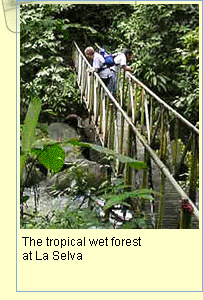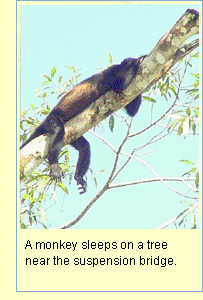
| Brazilian River Otters | |
| Mexican Wild Cats | |
 |
||
|
Ecologists, Dr. Lee Dyer and Dr. Grant Gentry have been working at
La Selva for many years. Dyer explains, "It was our concern about disappearing
wild areas of the world that led each of us to focus our research in
the rainforest." The scientists' objective is to document the diversity
of caterpillars and understand their impact on the rain forest ecosystem.
Earthwatch teams help find and raise the caterpillars.
Most of the forest at La Selva is considered tropical wet forest with
an average rainfall of 12 to 13 feet a year. Because it is so close
to the equator, the climate is warm and humid. The forest supports a
remarkable diversity of animals and plants. La Selva is home to over 2,000 species of plants. More than 100 species
of trees can be found in a 5-acre (2-kilometer) plot. This is certainly
a lot more than the 12 or less trees found in a temperate forest. Do
you know how many different trees can be found in your area?
There are also hundreds of birds and mammals. On a typical walk you
will see peccaries, coatis, sloths, monkeys, toucans, parrots, and at
least a dozen species of butterflies. Scientists estimate that there
are over 5,000 species of caterpillars at La Selva. Photos courtesy of Shauneen Giudice/Earthwatch Institute |
||
 La
Selva means "the forest" in Spanish and that is just where we're going!
Located in the Caribbean
La
Selva means "the forest" in Spanish and that is just where we're going!
Located in the Caribbean  From top to bottom,
each layer of the rainforest provides a completely different habitat for
different organisms to thrive. The canopy, for example, is made up of
the tops of very tall trees and receives direct sunlight, rain, and wind.
The forest floor is shaded and receives the rain indirectly as it trickles
down through many layers of leaves. Tropical rain forests are famous for
their
From top to bottom,
each layer of the rainforest provides a completely different habitat for
different organisms to thrive. The canopy, for example, is made up of
the tops of very tall trees and receives direct sunlight, rain, and wind.
The forest floor is shaded and receives the rain indirectly as it trickles
down through many layers of leaves. Tropical rain forests are famous for
their